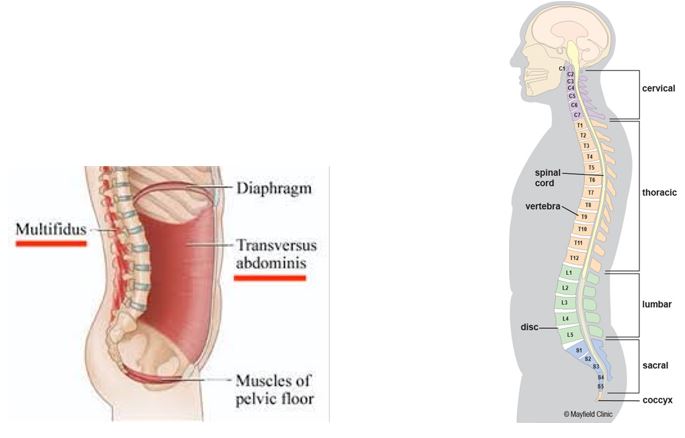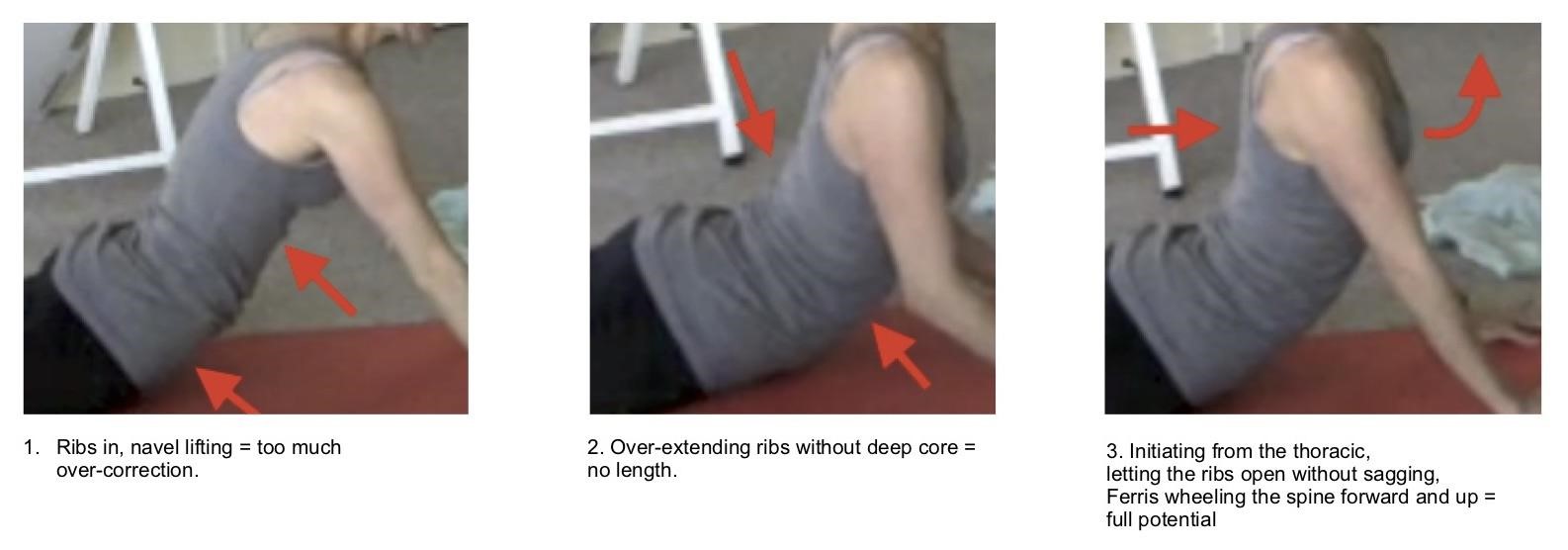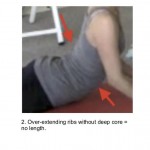When Swans Fly – Getting Higher Than You Thought You Could
By Chantill Lopez
May 16, 2018
And for the grand finale … we soar!
SEQUENCE –
Start where you move the least and allow the effort to ripple outward.
Now for the fun part. We’ve organized and initiated (in my previous article, “Fearless Extension – An Upside-Down Approach”). We’re essentially starting our Swan from a relaxed, slightly extended and efficiently supported position. It’s likely that there is still a little crease in the front of the hip (sit bones wide), which is going to feel super strange. Deep breaths. We’re thinking outside the box to access more potential. It’s not going to feel comfortable. Change never is 😉.
Sequence from the thoracic spine.
Our tendency to lift the eyes and head first, without appropriate — and subtle — deep core activation (transversus abdominis and multifidus), usually triggers an over-efforting in the neck and ultimately the low back, which we then must work to undo.
Instead, moving from the part of the spine that has the least amount of extension-potential (thoracic/mid-back) allows us to grow OUT into the curves that love extension.
- First – Inhale into the front of the rib cage imagining that you can move the xiphoid process away from the spine. Feel the breath open the ribs three-dimensionally creating deep inner support for the spine.
- Next – Use the arms to help draw the waist long, the ribs forward, and the heart toward the wall in front of you. Pause and breathe into the ribcage keeping it full and pliable.
- Then – Bringing attention into the space below the tips of the shoulder blades, soften downward (yes, downward) into a slight sagging as you exhale. On the inhale, draw the front of the thoracic spine (around T 8/9, lower sternum) forward to create more space and length. The movement should feel like each vertebra is on a Ferris wheel: moving toward, forward, and then lastly UP. Keep working through the mid-back to move forward, then up to the place where you feel ease in the neck, shoulders and a balanced effort along the entire spine.
What about the glutes – The glutes will begin to turn on at different points depending on the body. As you lose your hip crease, which you will as the chest moves forward and up (like a Ferris wheel), you’ll feel that the glutes and legs begin to activate. That’s your body moving into active hip extension to meet the spinal extension. Perfect.
Why it works – The more length you can foster, the more the transversus abdominis will contract and tone, co-contracting the multifidus. Voila, deep inner core support.

The ribs HAVE TO OPEN for the thoracic spine to get maximum extension. Without this, the work goes into the point where the low and mid backs meet (L1 – T12) and into the neck. Opening is crucial. If you notice that the lumbar spine is compressed and that the ribs are sagging downward without length, then adjust.
Consider cueing the deep low belly and glutes as an alternative to pulling the ribs in or together. If that doesn’t work, lower the trunk down until you can find the length and support you need.
The moment you pull the ribs together, you flex the thoracic spine (photo), which doesn’t serve the body as well as re-recruiting the low belly connection or finding more length through the waist.

Keys to progressing into a Fearless Swan:
- Foster continuous breath through the front and back of the rib cage. I like to use the cue “three-dimensional breathing” to get the body to expand in all directions. Coupled with “three-dimensional narrowing” to get the waist to narrow in all directions (not just navel to spine, which again pulls the spine into flexion). This is key not only in building to Swan Prep but what motivates or drives Rocking Swan.
- Through this progression, the head and neck will be light on the rest of the spine. During Swan Prep or Rocking Swan keep the eyes and jaw soft to continue this feeling. Try doing it with your eyes closed. 🙂*Note on the cervical spine: After practicing extension this way for a bit, freeing up the thoracic, opening the front body, and releasing unnecessary tension in the lumbar spine and shoulders, it is incredibly liberating to play with initiating from the head. In fact, my favorite way to do this is to draw forward with the chin, bring the gaze up the wall in front of you and continue to develop the lengthening across the throat. If enough balance is present in the spine, positioning the head and neck simply happens and the entire swan is bigger and more beautiful than ever.
- Develop appropriate range and strength in shoulder flexion and hip extension as they are the second thing (after breath) that drive Rocking Swan. The spine doesn’t necessarily have to do more in Rocking Swan (the breath will keep it strong, pliable, and stable enough to move through space while maintaining the shape). However, the arms and legs DO have to do to motivate you through space.
My choice prep exercises:
- Bridging, Shoulder Bridge, Bottom Lift, Control Front and Control Back/Leg Pull Up and Leg Pull Down, Down Stretch, Up Stretch, Knee Stretches (all), Swan on the Trapeze (no spring load, on the long box is a great place to prep Rocking Swan (photo)), Chest Expansion, Thigh Stretch, Hanging Pull Ups, Press Ups on the Chair, Swan on the Chair (rocking), Rocking Swan on the Step Barrel, Swan on the Ladder Barrel, Pulling Straps, T-pulls…(in no particular order).
Go slow, but not too slow. Take time to prepare the body over time and in a class or session. Trust the Method and trust the body in front of you. Thoughtful progression doesn’t mean walking on eggshells. Wise progression. Courageous teaching.
 Chantill Lopez – “Be real. Don’t fake it. Be able to say I don’t know. Laugh at myself. Extend compassion to myself and my students. Enter in fully, every time, ready or not.”
Chantill Lopez – “Be real. Don’t fake it. Be able to say I don’t know. Laugh at myself. Extend compassion to myself and my students. Enter in fully, every time, ready or not.”
After more than 20 years of teaching, 17 of which have been spent teaching Pilates, yoga, dance, meditation and other movement modalities to a complex variety of folks, Chantill’s passion is teaching teachers.
She holds Pilates certifications from the PhysicalMind Institute and Body Kinetics with Master Teacher Carol Appel, is a certified Vinyasa yoga teacher, and has extensively studied the work of Philip Beach, Yamuna Body Rolling, Feldenkrais, the Franklin Method, Authentic Movement, and the Halprin Life/Art Process, as well as Vipasana meditation, Buddhist psychology and The Work by Byran Katie. Chantill’s work currently explores brain-based learning and teaching, motivational strategies, and the integration of the whole-person based on such ideas as somatic and humanistic psychology and the polyvagal theory by Stephen Porges.
She is a Pilates Method Alliance Certified Pilates Teacher (CPT), a Balanced Body Pilates faculty member and the founder of the international education company, Skillful Teaching. Chantill is also the creator of the Thinking Pilates Podcast and author of the book “Moving Beyond Technique,” and the co-creator of the Science + Psychology of Teaching Master’s Program.
You can find Chantill teaching throughout the U.S. and offering online coursework and support to teachers around the world. She actively teaches out of several studios in the Northern California & Bay Area including Sonoma and Napa counties, Sacramento and San Francisco.

